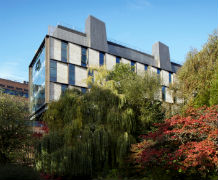Articles

Living Systems Institute building
Pioneering new technique could revolutionise super-resolution imaging systems
Scientists have developed a pioneering new technique that could revolutionise the accuracy, precision and clarity of super-resolution imaging systems.
A team of scientists, led by Dr Christian Soeller from the University of Exeter’s Living Systems Institute, which champions interdisciplinary research and is a hub for new high-resolution measurement techniques, has developed a new way to improve the very fine, molecular imaging of biological samples.
The new method builds upon the success of an existing super-resolution imaging technique called DNA-PAINT (Point Accumulation for Imaging in Nanoscale Topography) – where molecules in a cell are labelled with marker molecules that are attached to single DNA strands.
Matching DNA strands are then also labelled with a florescent chemical compound and introduced in solution – when they bind the marker molecules, it creates a ‘blinking effect’ that makes imaging possible.
However, DNA-PAINT has a number of drawbacks in its current form, which limit the applicability and performance of the technology when imaging biological cells and tissues.
In response, the research team have developed a new technique, called Repeat DNA-Paint, which is capable of supressing background noise and nonspecific signals, as well as decreasing the time taken for the sampling process.
Crucially, using Repeat DNA-PAINT is straightforward and does not carry any known drawbacks, it is routinely applicable, consolidating the role of DNA-PAINT as one of the most robust and versatile molecular resolution imaging methods.
The study is published in Nature Communications on 21st January 2021.
Dr Soeller, lead author of the study and who is a biophysicist at the Living Systems Institute said: “We can now see molecular detail with light microscopy in a way that a few years ago seemed out of reach. This allows us to directly see how molecules orchestrate the intricate biological functions that enable life in both health and disease”.
The research was enabled by colleagues from physics, biology, medicine, mathematics and chemistry working together across traditional discipline boundaries. Dr Lorenzo Di Michele, co-author from Imperial College London said: “This work is a clear example of how quantitative biophysical techniques and concepts can really improve our ability to study biological systems”.
Date: 21 January 2021
